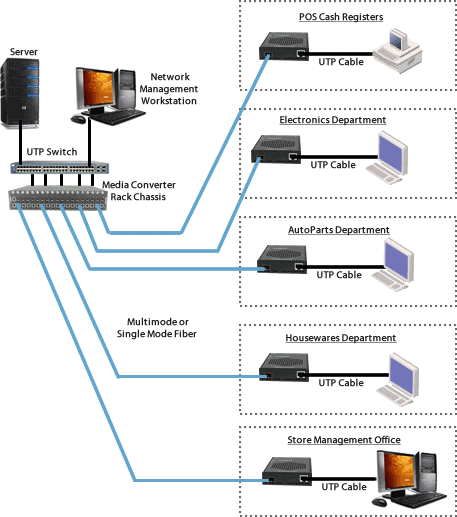Conversión de fibra a Ethernet apta para redes de comercio a gran escala
Las grandes empresas comerciales necesitan establecer redes extensas para dar apoyo a los equipos, las estaciones de trabajo y la tecnología de seguridad que requiere una gran red de dispositivos de punto de venta.
Muchas de estas empresas han comenzado a adoptar la tecnología de conversión de fibra a Ethernet para lograr una red de alto rendimiento a un precio asequible.
Las necesidades de conexión a red que tienen las grandes cadenas comerciales son en cierto modo específicas, aunque pueden atenderse mediante la tecnología de fibra a Ethernet. La red debe dar apoyo a todos los dispositivos instalados en el establecimiento y, con el fin de contener los costes, utilizar cables UTP de cobre. Sin embargo, los cables ópticos también son necesarios para cubrir largas distancias. Esta combinación convierte a la tecnología de conversión de fibra a Ethernet en la solución idónea para el sector del comercio.
Este sistema ofrece una serie de ventajas que se ajustan perfectamente a las necesidades de una gran cadena comercial. La primera de estas ventajas es que ofrece una infraestructura de red asequible. Dado que el grueso de la red está formado por cable de cobre, la mayor parte de la infraestructura solo precisa equipo Ethernet estándar en lugar de costosos equipos de fibra óptica.
Una ventaja más sutil procede del hecho de que dicha red esté completamente cableada. Dado que la infraestructura de red no requiere equipo inalámbrico, que normalmente es preciso alojar en el techo de los edificios o en otros lugares visibles, se evita que el establecimiento esté sobrecargado de equipos de red superfluos y, en cambio, se consigue que la red dependa de una arquitectura de cable que puede ocultarse fácilmente. Esto permite mantener despejadas de cables las zonas de exposición y lograr que el establecimiento sea lo más atractivo posible.
La ventaja operativa que ofrecen estas redes es también fundamental. La conversión de fibra a Ethernet permite a las empresas conectar dispositivos de punto de venta, departamentos, oficinas de administración y servicios de pedidos. Esto facilita la comunicación y la colaboración y proporciona un enlace importante en edificios demasiado grandes como para utilizar otros sistemas.

Establecer una infraestructura de fibra a Ethernet exige a las empresas comenzar con un solo servidor que conecte con un interruptor Ethernet basado en cobre en la sala principal de ordenadores. Este interruptor se conecta posteriormente a un controlador de administración de red para que supervise todas las funciones. También se conecta al interruptor un chasis de conversores de medios , lo que permite que la red Ethernet incluya cable óptico donde sea necesario. Cada extremo de la red, como puede ser un dispositivo de punto de venta, también dispone de un conversor de medios para cambiar la señal Ethernet UTP a señal óptica y devolverla a la sala de ordenadores.
El conversor Ethernet-fibra permite utilizar un transceptor de cobre para transformar enlaces Ethernet UTP y RJ45 a un formato que pueda ser procesado por un transceptor de fibra óptica. Esto crea una infraestructura consolidada montada en racks capaz de reunir diferentes enlaces de fibra en una única plataforma.
La capacidad de ofrecer una infraestructura asequible, de alto rendimiento y consolidada convierte a la arquitectura de fibra a Ethernet en la elección idónea para despliegues en grandes cadenas comerciales.